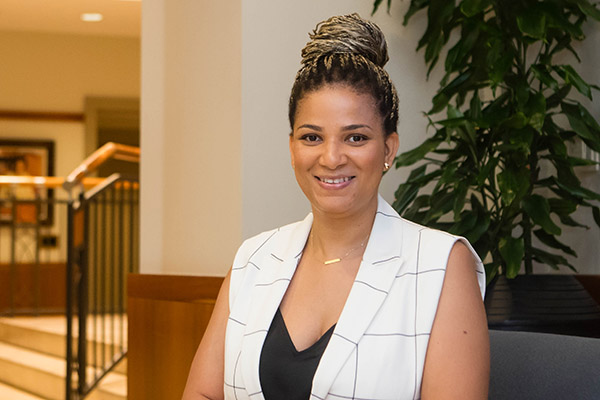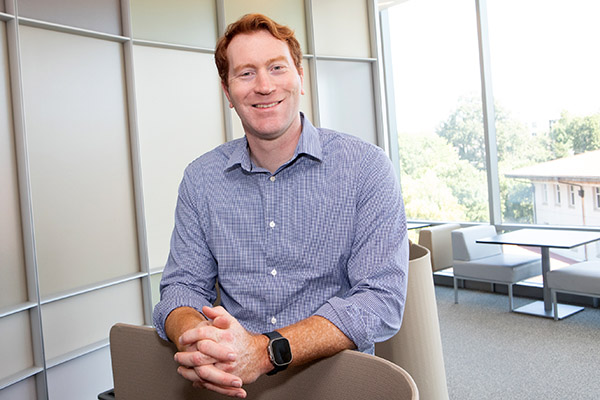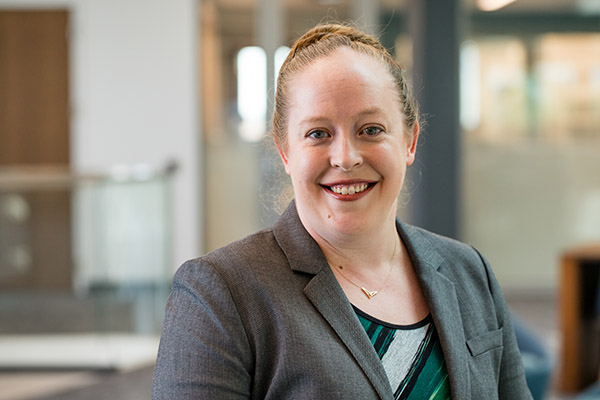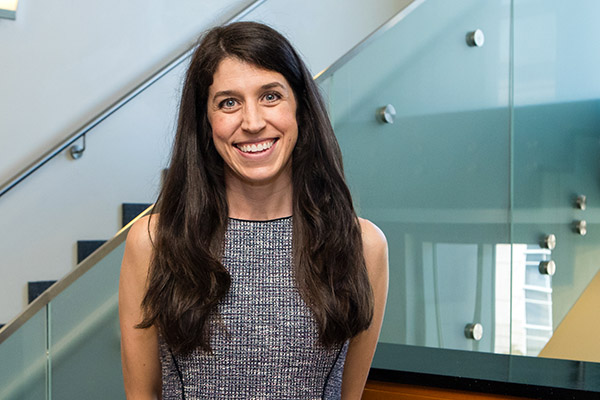Meet Four Winship Researchers
Meet four of Winship’s outstanding research scientists whose day-to-day work is changing the game in important ways for people with cancer.
Jessica Wells, PhD, FAAN

Jessica Wells, PHD, FAAN
Photo: Jenni Girtman
Wells is the assistant director of Winship’s Community Outreach and Engagement and an associate professor in the Nell Hodgson Woodruff School of Nursing at Emory University. Her research focuses on cancer control and prevention, particularly among those at risk for HIV. She recently completed a K01 Career Development Award in which she examined individual, interpersonal and neighborhood factors of adherence to follow-up after an abnormal anal Pap test in women living with HIV.
Q: Please tell us about your work aimed at cancer prevention among those at risk for HIV, such as increasing HPV vaccination in HIV community clinics?
A: Due to highly effective antiretroviral therapies, people living with HIV (PLWH) are now aging into a life expectancy of the general population. HIV is a chronic and manageable condition, but PLWH are now experiencing and impacted by non-AIDS related comorbidities, such as HPV-related cancers. Yet, evidence-based cancer screening and prevention strategies are not targeted or tailored for this high-risk population. Given that PLWH have the highest burden for anal cancer, promotion of HPV vaccination as a means of primary cancer prevention is of critical importance. My work partners with HIV community clinics to integrate a high-quality HPV vaccination recommendation and administration of the vaccine within clinical care.
Q: What are you most excited about in your research?
A: We have the tools to prevent HPV-related cancers, but work is needed to assure PLWH have equitable access to the HPV vaccine to help achieve as normal a life expectancy and quality of life as the general population. I’m most excited about the potential of my research to address a significant gap that targets a high-risk group and can reduce the clinical burden from vaccine- preventable HPV-related cancers.
Doug Walker, PhD

Douglas Walker, PhD
Photo: Jenni Girtman
Walker is a member of Winship’s Cancer Prevention and Control Research Program and an associate professor in the Gangarosa Department of Environmental Health at the Rollins School of Public Health at Emory University and adjunct assistant professor at Utrecht University. He is an environmental engineer and analytical chemist with training in metabolomics and developing EWAS (exposome-wide association study) methodologies for environmental health and precision medicine research.
Q: Please describe the methods you are developing for measuring biomarkers of complex exposures of emerging concern—including microplastics, e-waste and polyfluorinated chemicals?
A: While my research primarily focuses on blood, lung and breast cancer outcomes, these methods have been used to study a wide range of diseases and have increased our knowledge of how environmental exposures may contribute to increased risk of these diseases. We are also using these methods to develop new approaches to measure complex, emerging exposures of concern, including microplastics, per- and polyfluorinated compounds (PFAS, commonly referred to as “forever chemicals”) and exposures from electronics waste (e-waste). While these exposures are widespread, their assessment in human populations has been limited due to the difficulty in measuring the large number of chemicals in these classes. My hope is our research can greatly improve our understanding of these complex exposures in humans and potential associations with health risks.
Q: What are you most excited about in your research?
A: The relationship between exposures and human health is complex, and the methods we have developed and applied in our laboratory will be one of the key approaches to begin unravelling this complexity. What most excites me about our research is that we have the potential to detect and identify the exposures that may impact human health, increase disease risk and lead to environmental disparities. Identification of these exposures will lead to interventions that reduce or eliminate them and contribute to improving public health. I also hope that by developing approaches that allow us to monitor for new or emerging exposures, we are able to prevent additional harmful pollution in a proactive manner, rather than focusing on mitigating these exposures after they have become widespread pollutants.
Andrea B. Moffitt, PhD

Andrea B. Moffitt, PhD
Photo: Jenni Girtman
Moffitt is a member of Winship’s Cell and Molecular Biology Research Program and holds a joint appointment as assistant professor in the Department of Hematology and Medical Oncology and the Department of Human Genetics at Emory University School of Medicine. Moffitt aims to develop genomic tools for measuring treatment response, predicting clinical outcome and investigating the nature of residual cells in acute myeloid leukemia (AML) and other hematological malignancies.
Q: Please tell us about the genomic tools you are working to develop for measuring treatment response and predicting clinical outcome in acute myeloid leukemia and other cancers?
A: As a patient with cancer is treated and monitored, the levels and patterns of DNA from cancer cells detectable at the primary site of the cancer and in the blood can serve as a marker for a successful surgery, resistance to therapy or an impending relapse. Routine blood samples offer the opportunity to monitor patients by examining cancer cells or cell-free DNA in the blood.
My laboratory is developing genomic tools that can detect residual cancer cells remaining after a successful treatment. Strategies that we developed allow us to detect a single cancer cell among a million healthy cells, which is about a thousand times more sensitive than standard methods. Preliminary studies suggest that this test may be able to predict which patients with leukemia will experience relapse.
Q: What are you most excited about in your research?
A: We are now able to detect leukemic cells when they are at levels that doctors have never been able to see before. This opens the possibility of treating a patient whose leukemia is likely to relapse earlier than ever before. I am excited to integrate our work into clinical trials at Emory to help improve the timing and course of treatment for patients with leukemia, with promise for improving the lives of patients. I am also excited to train the next generation of scientists to tackle these challenging problems in cancer using genomic and bioinformatic approaches.
Lisa Sudmeier, MD, PhD

Lisa Sudmeier, MD, PhD
Photo: Jenni Girtman
Sudmeier is a radiation oncologist treating patients with brain and spinal tumors at Emory University Hospital and an assistant professor in the Department of Radiation Oncology at Emory University School of Medicine. Sudmeier’s research focuses on improving treatment for brain metastases and primary brain tumors, with a particular emphasis on immunotherapies. She aims to understand how the brain’s unique immune microenvironment interacts with the immune cells infiltrating tumors within the brain, and how different cancer treatments affect these cells. She is a member of Winship's Cancer Immunology Research Program.
Q: Please tell us how and why immunotherapies offer potentially significant treatments for brain metastases?
A: Up to 25% of patients who die from cancer are affected by brain metastases, which are also a source of significant neurologic morbidity. Immune checkpoint blockade (ICB), a type of immunotherapy that activates a patient's immune system to attack their cancer, has improved outcomes in multiple types of cancer, and some clinical data has shown that ICB can be effective in the brain. This is consistent with our results showing that the cells which are activated by ICB (PD-1+ CD8+ T cells) are present within brain metastases.
But many patients with brain metastases don't respond to ICB or only respond for a short time. We need to better understand what determines whether or not brain metastases will respond to ICB, how to increase the likelihood of an effective anti-tumor immune response in the brain and how to optimize multimodality therapy that involves surgery, radiation therapy, ICB and other systemic agents.
Q: What are you most excited about in your research?
A: We have recently focused on deciphering how the surrounding brain environment may be shaping the tumor immune landscape. Different neurotransmitters released by neurons in the brain may influence the tumor's microenvironment within the brain. Concentrations of these neurotransmitters, which are affected by many different commonly prescribed medications, could be an important factor regulating the tumor's ability to evade immune-mediated destruction. Another exciting project in the lab focuses on the crosstalk between T-cells and innate immune cells such as neutrophils. T-cells are the targets of ICB, but many other immune cells interact with T-cells to regulate their function and may have untapped therapeutic potential.





